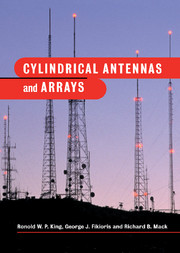Book contents
- Frontmatter
- Contents
- Preface
- Preface to first edition
- 1 Introduction
- 2 An approximate analysis of the cylindrical antenna
- 3 The two-element array
- 4 The circular array
- 5 The circuit and radiating properties of curtain arrays
- 6 Arrays with unequal elements: parasitic and log-periodic antennas
- 7 Planar and three-dimensional arrays
- 8 Vertical dipoles on and over the earth or sea
- 9 Dipoles parallel to the plane boundaries of layered regions; horizontal dipole over, on, and in the earth or sea
- 10 Application of the two-term theory to general arrays of parallel non-staggered elements
- 11 Resonances in large circular arrays of perfectly conducting dipoles
- 12 Resonances in large circular arrays of highly conducting dipoles
- 13 Direct numerical methods: a detailed discussion
- 14 Techniques and theory of measurements
- Appendix I Tables of Ψd R, T(m) or T′(m) and self-and mutual admittances for single elements and circular arrays
- Appendix II Tables of matrix elements Φu and Φυ for curtain arrays
- Appendix III Tables of admittance and impedance for curtain arrays
- References
- List of symbols
- Index
9 - Dipoles parallel to the plane boundaries of layered regions; horizontal dipole over, on, and in the earth or sea
Published online by Cambridge University Press: 07 August 2009
- Frontmatter
- Contents
- Preface
- Preface to first edition
- 1 Introduction
- 2 An approximate analysis of the cylindrical antenna
- 3 The two-element array
- 4 The circular array
- 5 The circuit and radiating properties of curtain arrays
- 6 Arrays with unequal elements: parasitic and log-periodic antennas
- 7 Planar and three-dimensional arrays
- 8 Vertical dipoles on and over the earth or sea
- 9 Dipoles parallel to the plane boundaries of layered regions; horizontal dipole over, on, and in the earth or sea
- 10 Application of the two-term theory to general arrays of parallel non-staggered elements
- 11 Resonances in large circular arrays of perfectly conducting dipoles
- 12 Resonances in large circular arrays of highly conducting dipoles
- 13 Direct numerical methods: a detailed discussion
- 14 Techniques and theory of measurements
- Appendix I Tables of Ψd R, T(m) or T′(m) and self-and mutual admittances for single elements and circular arrays
- Appendix II Tables of matrix elements Φu and Φυ for curtain arrays
- Appendix III Tables of admittance and impedance for curtain arrays
- References
- List of symbols
- Index
Summary
Introduction
Dipole antennas located parallel to the plane boundaries of a layered region have numerous important applications over a wide range of frequencies. Examples include horizontal-wire (Beverage) antennas in air close to the earth, insulated antennas on or below the surface of the earth or sea, cellular telephone transceivers close to the human head, and patch antennas on microstrip.
The electromagnetic field of a dipole antenna parallel to the surface of a layered region is more complicated than the field of the same dipole when perpendicular to the boundaries. This is a consequence of the fact that all six components of the electromagnetic field are involved. In the cylindrical coordinates ρ, Φ′, Z′ shown in Fig. 9.1, there are three components of electric type, namely, Eρ, EZ′, and BΦ′, and three components of magnetic type, namely, Bρ, BZ′, and EΦ′. The dipole with the length 2h and electric moment 2he I is located at the height d′ in the air (region 0, wave number k0) over the surface of the electrically thin layer (region 1, wave number k1, thickness l). This coats a dielectric or conducting half-space (region 2, wave number k2 = β2 + iα2). The vertical Z′ = –Z axis passes through the center of the dipole. The field in the air, Z′ ≥ 0, is expressed in terms of the coordinates ρ, Φ′, Z′.
- Type
- Chapter
- Information
- Cylindrical Antennas and Arrays , pp. 343 - 378Publisher: Cambridge University PressPrint publication year: 2002



